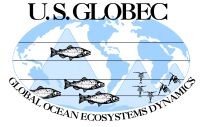August 10, 2002
Fine scale survey continues
8:00 a.m.: Rough conditions this morning on the Revelle greet
the scientists who will continue the fine scale survey in the north
today.
.jpg)
8:45 a.m.: Chief Scientist Daily report for 9 August 2002
We deployed the HTI bioacoustics instrument and the SeaSoar inshore on
the
Newport Hydrographic Line (Line 1) at midnight on Thursday. Lots of
boat
traffic near Newport, but it was a crystal clear night. We surveyed on
lines 1 and 1A of the Fine-Resolution North survey region before
recovering the HTI and SeaSoar at 0800 on Friday 8/9. The Revelle's
zodiac was used to transfer Ricardo Letelier to the R/V Elakha in
return
for some filters for the flow-through bio-optics group and refrigerant
for the Chief Engineer. The seas were calm and the transfer went
smoothly. We were back SeaSoaring on Line 2 at 1000. There was a
hotspot
of activity on the offshore side of line 2A, at 44 22.8N, 124 42'W.
This
was the western edge of a very high chlorophyll feature. HTI echoes
were
solid to the bottom inshore of this point. Many humpbacks and sizeable
bird populations. This looks to me like the continuation of a
chlorophyll
front running along the isobaths, but it is not very strong on the NH
line.
We had heavy fog most of the day on Friday, most likely the result of
warmer, moisture laden air meeting the cold upwelled water on the
Heceta
Bank. This shutdown the upper tropic (birds and mammals) observations
and
necessitated the blowing of the fog horn. High values of chlorophyll
remain over the Bank and the flow-through system filters need to be
changed frequently.
We are now about to head offshore on Line 4. The fog has lifted. Our
ETA
on the inshore end
of Line 4A and the conclusion of the Fine-Resolution North survey is
around 2300 tonight (Sat 8/10). We will then head for the last
reported
position of the bio-optical drifters, locate them, and then complete
about
6 hours of station work next to them. If time permits during the early
hours Sunday, we may try and complete a couple of CTD stations beneath
the
high chlorophyll plume off Yachats. We have an oxygen sensor on our
CTD
profiler and we can investigate the status of low-oxygen bottom waters
reported for that area earlier in the summer.
After the station work near the bio-optical drifters we'll transit to
the
Southern Fine-Resolution survey area and start the survey
on Line 7. I know the bird and mammal observers are excited to return
to
that area since they saw many humpback whales and birds on the inshore
end
of line 8 (Coquille Bank). Winds are forecast to pick up and be
especially strong near Cape Blanco. Should be interesting.
Attached is a report of bird observations from David Ainley and his
fellow observers Cyndy Tynan, Chuck Alexander and Tom Ryan.
Seabirds seen on GLOBEC 2002 August Mesoscale Survey
300 m-wide transect strip (David Ainley, August 9, 2002)
Number Habitat
----- -------
Black-footed Albatross 32 Slope
Sooty Shearwater 634 Inshore, upwelling front
Pink-footed Shearwater 166 Inshore, upwelling front
Northern Fulmar 27 Shelf
Hawaiian Petrel* 1 Warm, off shelf
Cook's Petrel* 3 Warm, off shelf
Leach's Storm-Petrel 614 Warm, off shelf
Fork-tailed Storm-Petrel 354 Shelf, slope
White-winged Scoter 1 Inshore
Red Phalarope 1055 Warm, off shelf
Red-necked Phalarope 433 Inshore, upwelling front
South Polar Skua 2 Warm, off shelf
Pomarine Jaeger 5 Warm, off shelf
Parasitic Jaeger 31 Warm, off shelf
Long-tailed Jaeger 71 Warm, off shelf
Western Gull 65 Inshore, upwelling front
Herring Gull 1 Shelf
Sabine's Gull 22 Warm, off shelf
Arctic Tern 27 Warm, off shelf
Common Murre 893 Inshore, upwelling front
Cassin's Auklet 5168 Inshore, upwelling front, South
Rhinoceros Auklet 60 Slope, shelf
Tufted Puffin 3 Slope, shelf
Marbled Murrelet 4 Inshore
Xantus/Craveri Murrelet 1 Warm, offshore
* New species for Oregon waters
---Jack Barth, Chief Scientist R/V Roger Revelle
filed 0845 PDT August 10 2002
3:00 p.m.: The skies have cleared and the Revelle is on the last
leg of the fine scale grid in the north. After completing this
leg late tonight, the next task will be to relocate the ship in the
vicinity of the optical drifters for more water samples and
bio-optical profiling. The wind and waves forecast for Sunday
may pose some difficulty in locating the 0.5 meter diameter orange
drifters.
.jpg) .jpg)
3:30 p.m.: The SeaSOAR was pulled out of the water at 3:30 p.m.
Something in the water, possibly a crab pot or some type of fishing
gear, snagged one of the power couplers on the PAR sensor and the AC9.
The PAR sensor has been removed and work is underway to get everything
set on the SeaSOAR so it can go back in the water. The
scientists plan for these mishaps by taking with them a complete set
of SeaSOAR parts.
.jpg) .jpg) .jpg)
4:20 p.m.: The SeaSOAR is patched up and back in the water.
More repair work will be done when it is removed from the water late
tonight.
.jpg) .jpg)
All Video clips are created in Windows Media
Player format. The broadband version is for cable or DSL users. The
56K version is for dial-up modem internet users. Find the
Windows Media Player for other operating systems here.
Previous update August 9
Next update August 11 |


.jpg)
.jpg)
.jpg)
.jpg)
.jpg)
.jpg)
.jpg)
.jpg)

.jpg)

